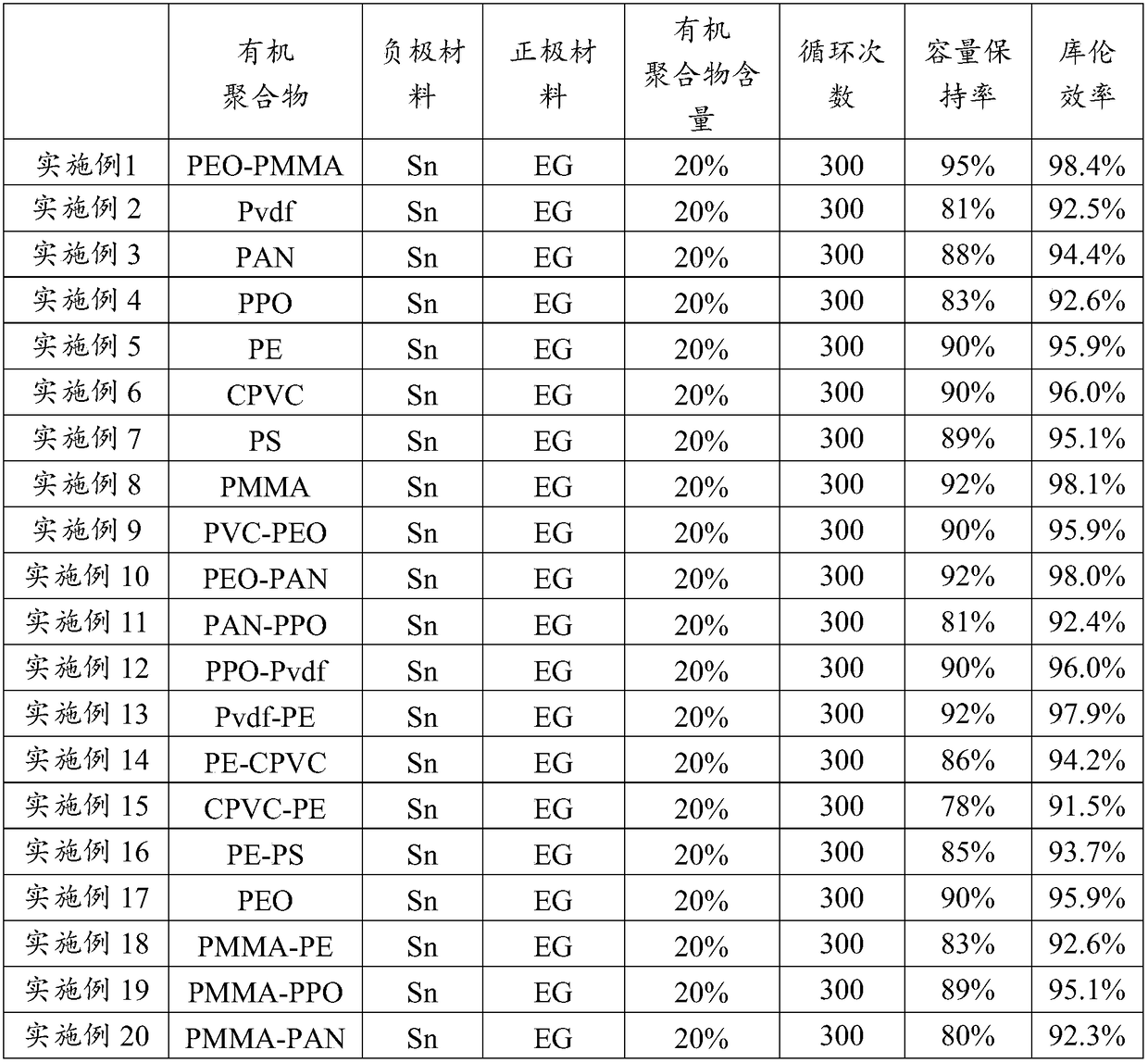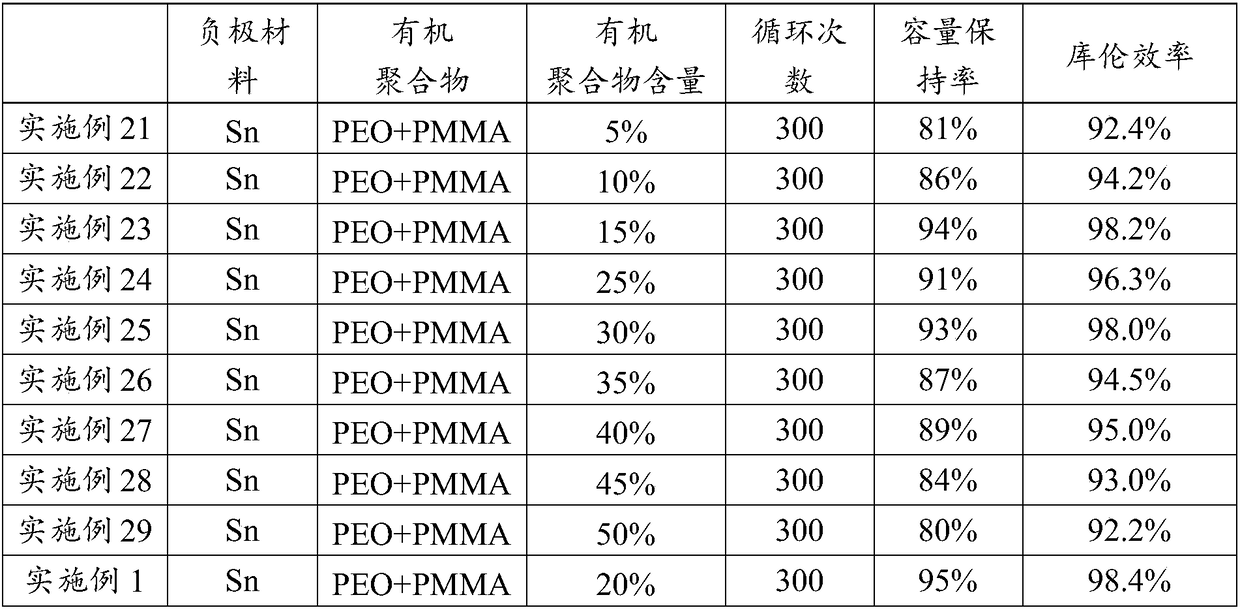Organic gel electrolyte, application, sodium-based double-ion organic solid-state battery and preparation method thereof
An organic gel and solid-state battery technology, applied in the direction of organic electrolyte, electrolyte immobilization/gelation, non-aqueous electrolyte, etc., can solve the problems of SEI film instability, high temperature of ceramic electrolyte, explosion, etc., to improve the cycle Stability, good ion conduction performance, and the effect of broadening the application field
- Summary
- Abstract
- Description
- Claims
- Application Information
AI Technical Summary
Problems solved by technology
Method used
Image
Examples
Embodiment approach
[0078] As a preferred embodiment, the ionic liquid includes 1-ethyl-3-methylimidazole-hexafluorophosphate, 1-ethyl-3-methylimidazole-tetrafluoroborate, 1-ethyl-3 -Methylimidazole-bistrifluoromethylsulfonimide salt, 1-propyl-3-methylimidazole-hexafluorophosphate, 1-propyl-3-methylimidazole-tetrafluoroborate, 1 -Propyl-3-methylimidazole-bistrifluoromethylsulfonimide salt, 1-butyl-1-methylimidazole-hexafluorophosphate, 1-butyl-1-methylimidazole-tetrafluoro Borate, 1-butyl-1-methylimidazole-bistrifluoromethylsulfonimide salt, N-butyl-N-methylpyrrolidine-bistrifluoromethylsulfonimide salt, 1 -Butyl-1-methylpyrrolidine-bistrifluoromethylsulfonimide salt, N-methyl-N-propylpyrrolidine-bistrifluoromethylsulfonimide salt, N-methyl,propane One or at least two of N-methylbutylpiperidine-bistrifluoromethylsulfonimide salts or N-methylbutylpiperidine-bistrifluoromethylsulfonimide salts.
[0079] [Organic polymer]
[0080] Typical but non-limiting mass percentages of organic polymers are,...
Embodiment 1
[0175] A sodium-based dual-ion organic solid-state battery includes a negative electrode, a separator, an organic gel electrolyte, and a positive electrode.
[0176] Prepare the negative electrode: use the tin foil integrated with the current collector and the negative electrode, and ultrasonically clean the tin foil with deionized water, acetone, and ethanol for 3-5 minutes, and cut it into a disc with a diameter of 12mm after drying, as the negative electrode for later use ;
[0177] Preparation of the separator: the glass fiber film was cut into discs with a diameter of 16 mm and used as a separator for later use.
[0178] Preparation of organogel electrolyte: Weigh 3g of sodium hexafluorophosphate and add it to 5mL of a mixed solvent of ethylene carbonate, dimethyl carbonate and ethyl methyl carbonate, stir until sodium hexafluorophosphate is completely dissolved, then add 5% The fluoroethylene carbonate is used as an additive, and after being fully stirred evenly, an org...
Embodiment 2-20
[0182] The sodium-based dual-ion organic solid-state batteries of Examples 2-20 all adopt the same tin foil negative electrode material, glass fiber separator, the same electrolyte salt, the same concentration of electrolyte and graphite positive electrode material as in Example 1, the difference is the addition of organic polymer.
[0183] The electrochemical properties of Example 1 and Examples 2-20 were tested, including the number of cycles, capacity retention and Coulombic efficiency. The test method is as follows:
[0184] Cycle charge and discharge: cycle charge and discharge are carried out on CT2001C-001 blue electric battery cycle test system, and the standard capacity of the electrode is tested by charging and discharging at a rate of 100mA / g, the specific capacity of the material = current * time / sample mass, the energy density of the material = specific capacity of the material * plateau voltage of the battery, the charging and discharging conditions depend on ...
PUM
| Property | Measurement | Unit |
|---|---|---|
| Diameter | aaaaa | aaaaa |
Abstract
Description
Claims
Application Information
 Login to View More
Login to View More - R&D
- Intellectual Property
- Life Sciences
- Materials
- Tech Scout
- Unparalleled Data Quality
- Higher Quality Content
- 60% Fewer Hallucinations
Browse by: Latest US Patents, China's latest patents, Technical Efficacy Thesaurus, Application Domain, Technology Topic, Popular Technical Reports.
© 2025 PatSnap. All rights reserved.Legal|Privacy policy|Modern Slavery Act Transparency Statement|Sitemap|About US| Contact US: help@patsnap.com



